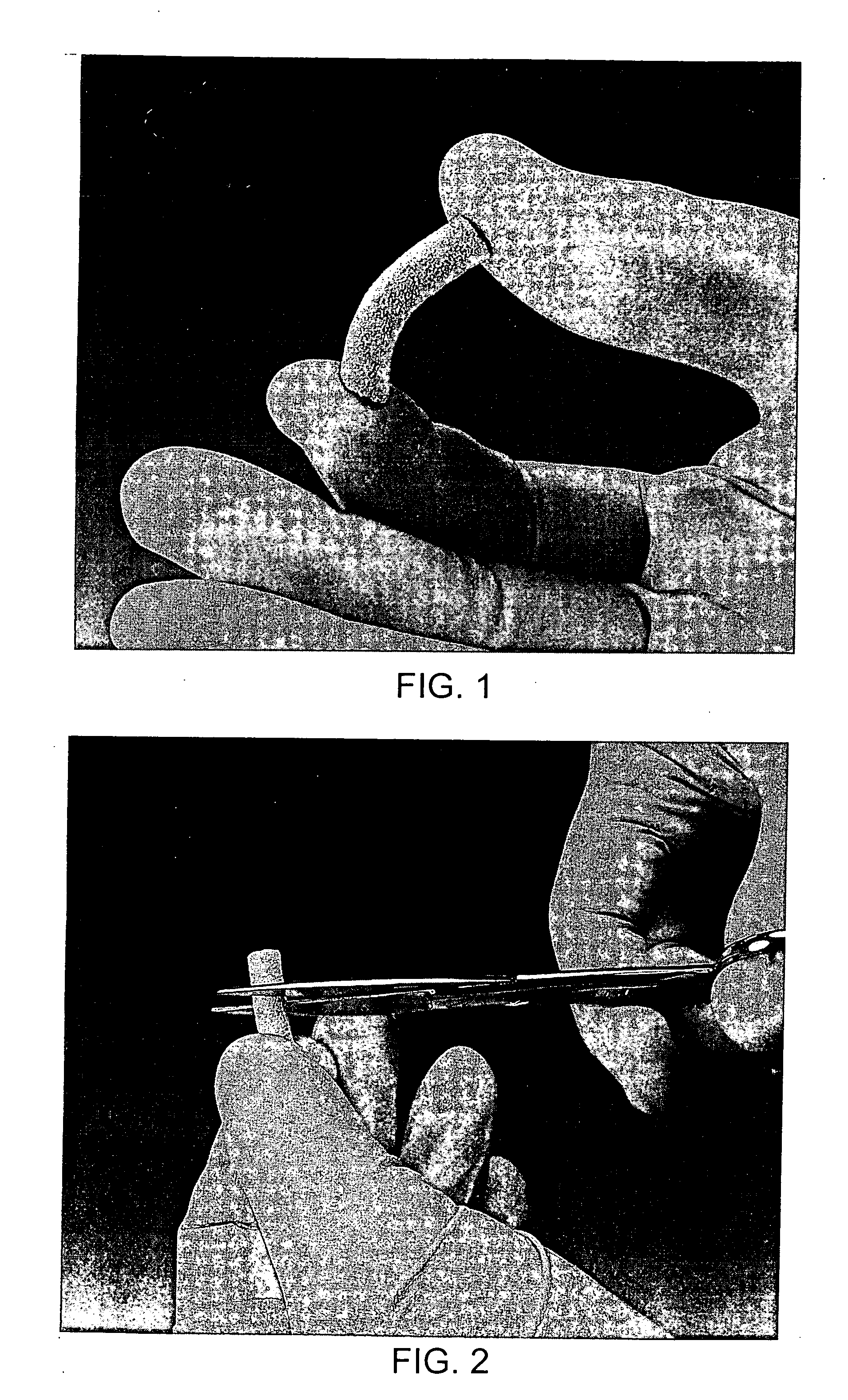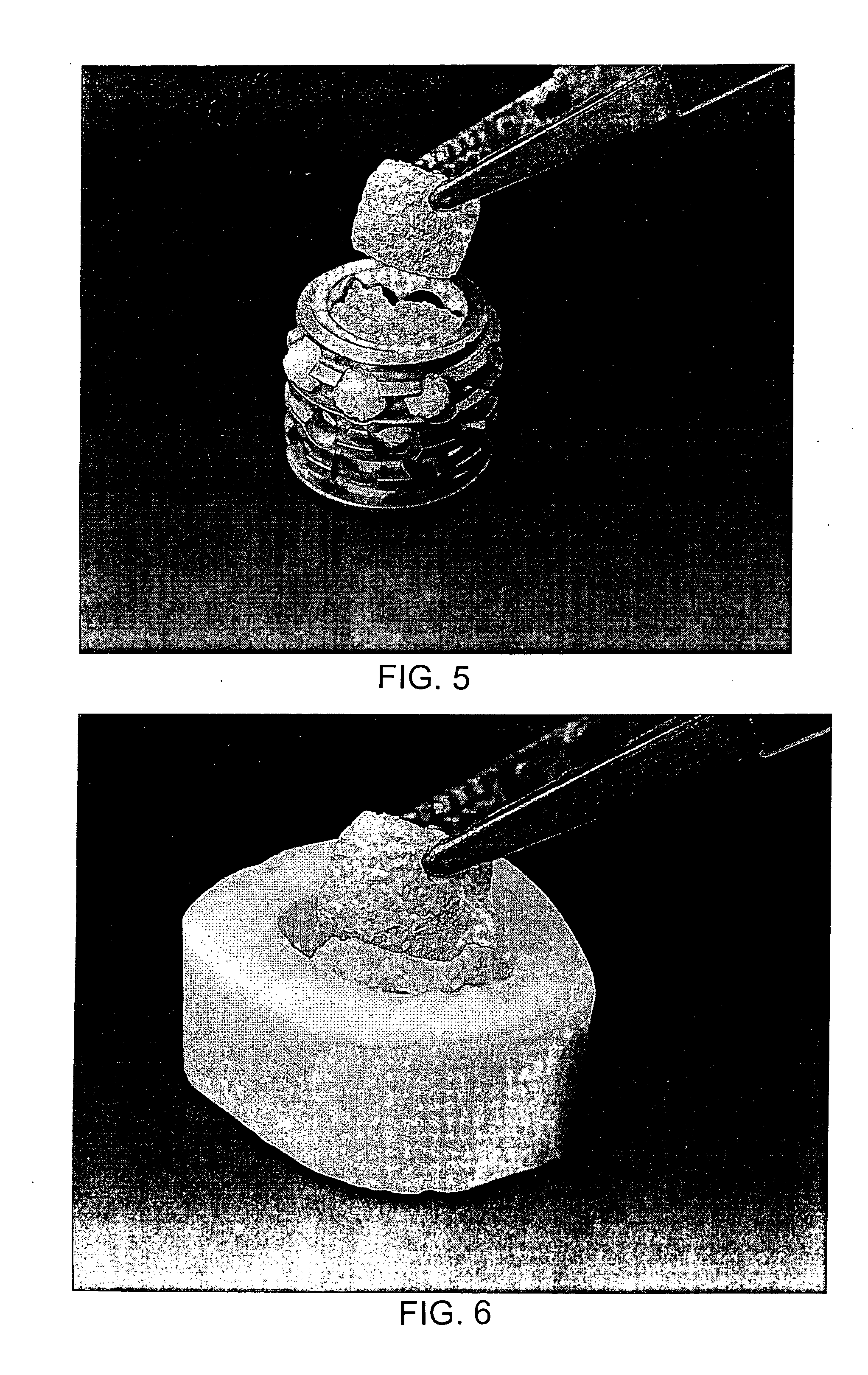Pliable medical device and method of use
a medical device and flexible technology, applied in the field of surgical repair of skeletal elements, can solve the problems of insufficient approach, inability to feasibly be pieced together, and inability to prevent bone loss
- Summary
- Abstract
- Description
- Claims
- Application Information
AI Technical Summary
Problems solved by technology
Method used
Image
Examples
example 1
Preparation of Lyophilized Cylinders
[0026] An extrusion device is fitted with a 6.5 mm diameter orifice and filled with the putty prepared as described above. Cylinders, fifty mm in length, are extruded from the device onto a chilled (−30° C.) metal plate, or any other appropriate chilled surface. The cylinders are further cooled to −55° C. on the shelves of a lyophilization vessel. Lyophilization is a means of water removal, achieved by freezing a wet substance and causing the ice to sublime directly to vapor by exposing it to a surrounding low pressure. A vacuum of 200 mTorr is applied to the frozen cylinders and maintained for eighteen hours. During that time the lyophilization chamber is allowed to warm to room temperature, approximately 25° C., or heated somewhat to speed up the sublimation process. These conditions are sufficient to reduce the water content of the cylinders to about 3%. The resulting lyophilized cylinders are dry in appearance, flexible and able to absorb blo...
example 2
Preparation of Lyophilized Sheets
[0030] The putty prepared as described above is loaded by injection into a Delrin mold containing a channel, twenty-four mm wide by four mm deep by 150 mm in length. The sheet-like mold is fitted with a releasable top plate that is typically bolted to the bottom plate. The loaded sheet-like mold is placed into a freezing unit and the sheet-like mold and putty are cooled to −55° C. After reaching this desired temperature, the top plate of the sheet-like mold is loosened to allow water to sublime away, and the sheet-like mold, still cold, is placed into a lyophilization chamber at 135 mTorr. During the sublimation process the lyophilization chamber is allowed to gradually warm to room temperature, approximately 25° C., or heated somewhat to speed up the sublimation process. The resulting dry flexible lyophilized sheet is easily removed from the mold and cut with standard scissors (FIG. 4). The lyophilized sheet is compliant for fitting onto an irregul...
example 3
Preparation of Lyophilized Cubes
[0032] The putty prepared as described above is pressed into a Delrin mold, using a stainless steel laboratory spatula, or any other suitable utensil, or by hand, to create cubes, one centimeter on edge. The mold and putty is frozen on a dry ice slab, or any suitably chilled surface or freezer shelf or with liquid nitrogen, and placed, still frozen, into a lyophilization flask. The putty is then subjected to a vacuum of 125 mTorr for forty-eight hours while warming the lyophilization chamber to room temperature, approximately 25° C. The lyophilized cubes can be sterilized in a steam autoclave, as described above, prior to use. The lyophilized cubes are dry in appearance but flexible and readily soak up blood and mix easily with bone marrow aspirate. The lyophilized cubes could be mixed with autograft bone harvested by conventional techniques from areas such as the iliac crest and serve to expand the useful volume of bone graft material available to t...
PUM
| Property | Measurement | Unit |
|---|---|---|
| Diameter | aaaaa | aaaaa |
| Diameter | aaaaa | aaaaa |
| Diameter | aaaaa | aaaaa |
Abstract
Description
Claims
Application Information
 Login to View More
Login to View More - R&D
- Intellectual Property
- Life Sciences
- Materials
- Tech Scout
- Unparalleled Data Quality
- Higher Quality Content
- 60% Fewer Hallucinations
Browse by: Latest US Patents, China's latest patents, Technical Efficacy Thesaurus, Application Domain, Technology Topic, Popular Technical Reports.
© 2025 PatSnap. All rights reserved.Legal|Privacy policy|Modern Slavery Act Transparency Statement|Sitemap|About US| Contact US: help@patsnap.com



